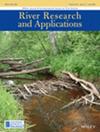Leveraging understandings of biogeomorphic river recovery to reframe river management philosophy and communication strategies
IF 1.9
4区 环境科学与生态学
Q4 ENVIRONMENTAL SCIENCES
引用次数: 0
Abstract
A philosophical and communication shift is needed in river management if we are to meet sustainable development goals and tackle environmental challenges brought about by ongoing anthropogenic and climate change. In some parts of the world, recovery‐enhancement approaches to river management have been adopted, communicated and used for many years. At the heart of these approaches lies an understanding of the biogeomorphic forms, processes and evolutionary trajectories of rivers that differs philosophically from notions of restoration, rewilding or creation of a utopian natural state. Instead, recovery‐enhancement approaches aim to improve the biogeomorphic condition of rivers, recognising that they are dynamic entities and new evolutionary trajectories and novel ecosystems are being created that are now part of the environment. Accepting shifting baselines and moving targets is inherent as boundary conditions (water, sediment and vegetation interactions) continue to be altered under the influence of anthropogenic and climate change, and the impacts of ‘unprecedented’ wildfires, floods, heatwaves and drought are manifested on the ground. The river management sector has not yet fully adapted to this reality with large amounts of applied science and on‐ground practice still focussed on restoration, re‐engineering and rewilding, words which in themselves produce a false impression of the aims, visions and achievability of river management. Embracing recovery‐enhancement approaches to river management requires a conscious shift in communication strategies and terminology to present more realistic expectations and possibilities for river condition improvement, a responsibility that is incumbent upon us, the scientists and practitioners, who work in the applied science and river management profession. In this Short Communication, I use a case study from eastern Australia to illustrate what biogeomorphic river recovery can look like. I use this to discuss the potential for adoption of a recovery‐enhancement approach to river management more broadly, and call on scientists and practitioners to make a conscious philosophical and communications shift when working in applied science and river management.利用对河流生物地貌恢复的理解,重新构建河流管理理念和传播战略
如果我们要实现可持续发展目标,应对人类活动和气候变化带来的环境挑战,就必须在河流管理方面转变理念和交流方式。在世界上的一些地方,多年来一直在采用、传播和使用恢复-强化方法来管理河流。这些方法的核心在于对河流的生物地貌形态、过程和进化轨迹的理解,在哲学上不同于恢复、野化或创造乌托邦式自然状态的概念。相反,恢复-强化方法旨在改善河流的生物地貌状况,认识到河流是动态实体,新的进化轨迹和新的生态系统正在形成,现已成为环境的一部分。在人为因素和气候变化的影响下,边界条件(水、沉积物和植被之间的相互作用)不断发生变化,"前所未有 "的野火、洪水、热浪和干旱的影响也在当地显现,因此,接受不断变化的基线和移动目标是与生俱来的。河流管理部门尚未完全适应这一现实,大量的应用科学和实地实践仍集中在恢复、再造和野化上,这些词语本身就给人一种河流管理的目标、愿景和可实现性的错误印象。要在河流管理中采用恢复-强化方法,就需要有意识地改变交流策略和术语,为河流状况的改善提出更切合实际的期望和可能性,这是我们--从事应用科学和河流管理专业的科学家和实践者--义不容辞的责任。在这篇短文中,我利用澳大利亚东部的一个案例研究来说明生物地貌河流恢复可能是什么样子。我借此讨论了在河流管理中更广泛地采用恢复-强化方法的可能性,并呼吁科学家和从业人员在从事应用科学和河流管理工作时,有意识地进行哲学和交流方面的转变。
本文章由计算机程序翻译,如有差异,请以英文原文为准。
求助全文
约1分钟内获得全文
求助全文
来源期刊

River Research and Applications
环境科学-环境科学
CiteScore
4.60
自引率
9.10%
发文量
158
审稿时长
6 months
期刊介绍:
River Research and Applications , previously published as Regulated Rivers: Research and Management (1987-2001), is an international journal dedicated to the promotion of basic and applied scientific research on rivers. The journal publishes original scientific and technical papers on biological, ecological, geomorphological, hydrological, engineering and geographical aspects related to rivers in both the developed and developing world. Papers showing how basic studies and new science can be of use in applied problems associated with river management, regulation and restoration are encouraged as is interdisciplinary research concerned directly or indirectly with river management problems.
 求助内容:
求助内容: 应助结果提醒方式:
应助结果提醒方式:


